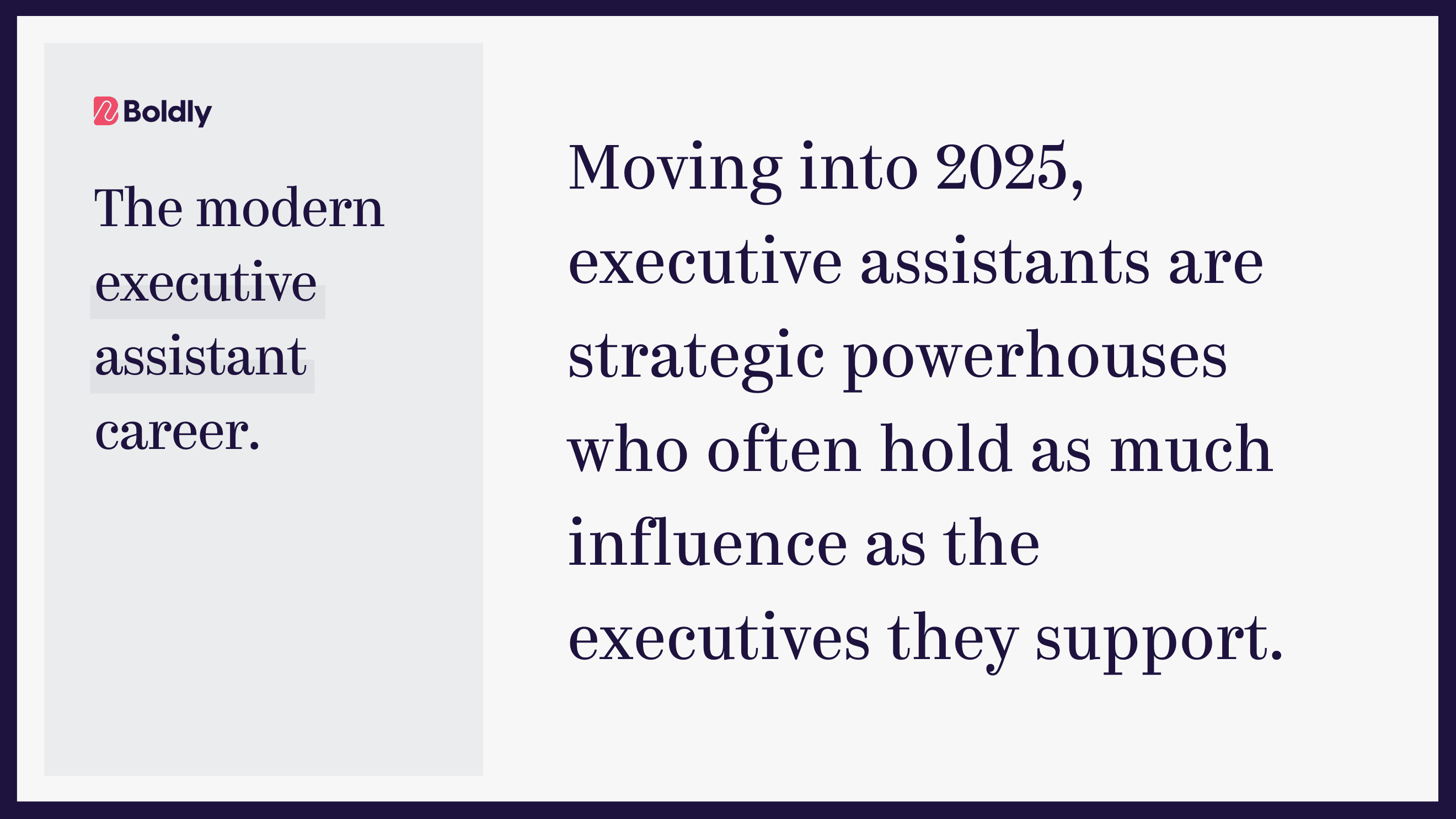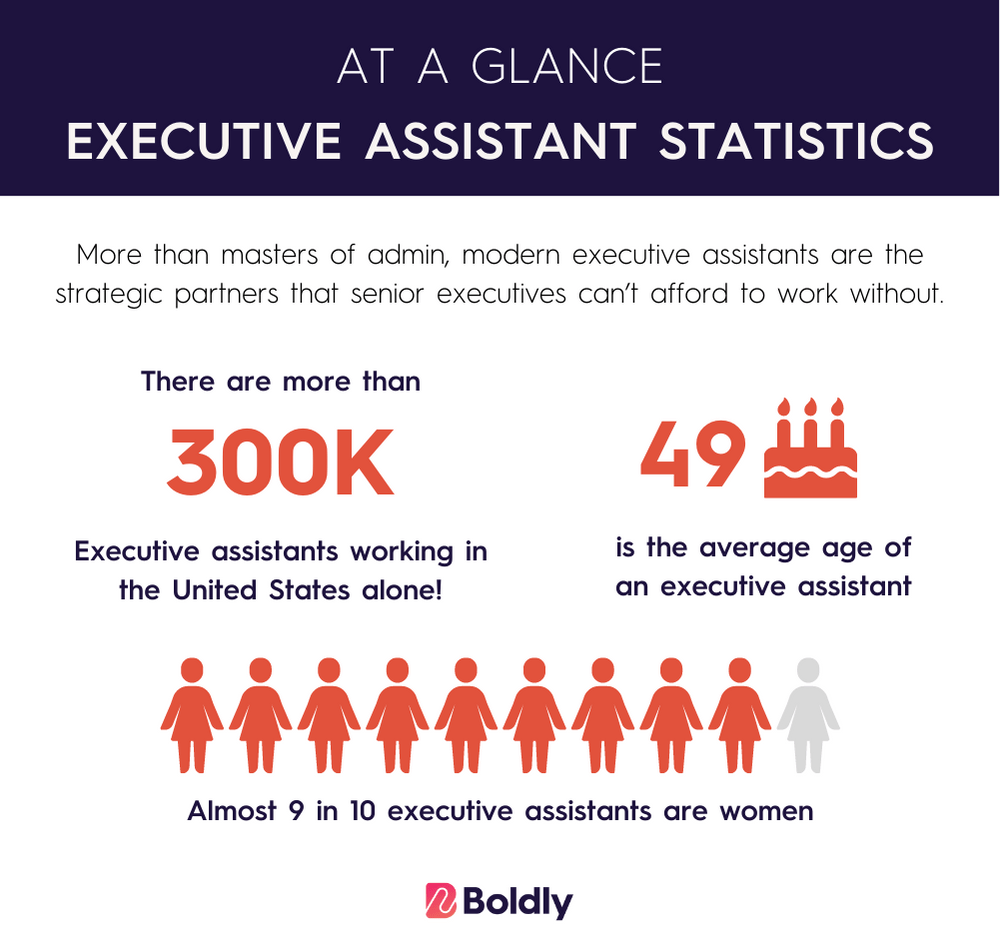Gone are the days when executive assistants were seen as purely administrative support. Moving into 2025, they’re strategic powerhouses who often hold as much influence as the executives they support.
The rise of AI has automated routine tasks, freeing EAs to tackle complex business challenges. Remote work has turned them into digital command centers for global teams. And in an era of constant change, their ability to navigate uncertainty while keeping organizations running smoothly has become invaluable.
But just how dramatic is this evolution? What does it mean for both businesses and careers? And how are compensation packages shifting to match these expanded responsibilities?
Let’s dive into the executive assistant statistics that reveal the true scope and impact of this rapidly evolving profession.


Who are they? What exactly do they do? How has the role evolved post-pandemic?
Let’s answer all of that and more through the lens of the top 15 executive assistant statistics that tell quite an interesting story.
Profile Of The Modern Executive Assistant
Right now, there are over 304,678 executive assistants working in the United States alone.
Most of them are women, making up almost 87% of all executive assistants.
The average age of an executive assistant is 49 years old. This means they have lots of experience, which is helpful in a business world that’s always changing, especially with recent shifts due to the pandemic.
When we look at ethnicity, most executive assistants are White (71.0%). The next biggest groups are Hispanic or Latino (11.2%), Black or African American (7.6%), and Asian (5.0%).
There’s a need for more diversity in this job to boost creativity and better problem-solving. (However, as a top inclusive workplace we’ve seen that a remote working model can actually boost diversity and inclusion!)
In summary, today’s executive assistants are mostly experienced women who play a key role in running businesses across the United States. They are adapting and changing to fit our uncertain business climate.
What Executive Assistants Make: Compensation Trends and Growth
The role’s evolution into a strategic position is reflected in what executive assistants make today. As of 2025, compensation packages have grown significantly to match the expanded responsibilities and technical expertise required.
According to recent data, how much executive assistants make varies based on experience level and location, with the national average base salary ranging from $35,000 to $71,000 per year.
High-level executive assistants supporting C-suite executives in major metropolitan areas can command salaries exceeding $104,000, especially when factoring in bonuses and benefits packages.
The shift toward remote work has also influenced compensation structures.
Virtual assistant statistics show that remote EAs often earn 15-20% more than their in-office counterparts, primarily due to their ability to support multiple executives and manage complex digital workflows. In particular, Boldly executive assistant professionals who have mastered both traditional EA skills and modern digital tools command premium rates, often 25-30% above industry averages.
Key factors influencing executive assistant compensation in 2025 include:
- Technical proficiency with AI and automation tools
- Experience managing hybrid or remote teams
- Strategic decision-making capabilities
- Cross-functional project management expertise
The Shift To Remote Work And Tech Savviness For Executive Assistants
COVID-19 changed the way we work for good. And today, executive assistants are becoming much more technology-centric. Executive assistants are commonly required to be the command center for an entire hybrid staff.
Virtual assistant statistics reveal that 70% of EAs now work in hybrid models, with remote capabilities becoming a standard requirement. The Boldly executive assistant role has evolved to encompass virtual team leadership, with many professionals managing distributed teams across multiple time zones.
This shift has notably impacted what executive assistants make, as virtual EAs often command higher salaries due to their expanded skill sets and ability to support multiple executives efficiently
They frequently need to know how to leverage SEO marketing, writing blog and social media content, create presentations, run virtual meetings and breakout sessions, execute surveys, manage productivity apps, and use project management software—on top of the typical scheduling, travel booking, and inbox management.
The rapid shift to remote work forced companies to adopt new technology and find ways to stay connected during quarantines.
This shift continues to pave the way for experienced women like moms, caregivers, military spouses, and more to work as high-level remote executive assistants. Plus, research from McKinsey Global Institute found that tasks with higher work-from-home potential perfectly match the role of the modern EA.
Add to this, EAs now constantly upskill to stay competitive—which puts them in solid control of their career trajectory. Data says 77% of employers see workers who upskill regularly as more appealing candidates.
One of the primary ways EAs are boosting their tech savviness and productivity is by embracing AI. (We’ve certainly done the same at Boldly.) They’re also spending more time on digital training and onboarding, overseeing requested IT work, and managing virtual meetings.
This exemplifies their sharp departure from a purely administrative role. They’re being trusted to lead and manage organizational changes, too.
However, as the executive assistant role has grown in strategic importance, so have the risks to their physical and mental health.
Burnout And Underutilization Are Real Concerns
As the proverbial “backbones” of their companies, executive assistants are at risk of burning out.
- 41% of American workers are experiencing burnout — that’s more now than at the height of the pandemic, Forbes says.
- Younger employees and women are more likely to report burnout. However, a supportive culture and ample flexibility can help reverse the trend. Remote work offers the chance for a better work-life balance, and fewer work stressors, such as a commute. Wise EAs and employers can lean on this as a solution and even prevention.
- A study from Old Dominion University sheds light on another layer of workplace wellness: “The single most effective way organizations can achieve a satisfied workforce is to provide their employees with mentally challenging work.” This should be a focus area for every organization with EAs.
- Executive assistants on CareerExplorer rated their skills utilization 2.6 out of 5.
Most feel that their skills are being underutilized, which can lead to dissatisfaction with their role. This means there’s a great opportunity for CEOs to trust their EAs more and look at ways to build a culture of appreciation and gratitude.


Challenge them with meaningful and expanded projects. Offer opportunities to upskill. Use their full skillsets so you don’t leave talent on the table.
Your company will benefit as much as your team does.
Mapping The Future: The Expanding Role And Influence of Executive Assistants
It’s clear that executive assistants have influence at the decision-making table.
Their future is big and bright. As the role evolves, it will bring more challenging tasks and complexities. But with that responsibility comes the chance to make an even greater difference while advancing a meaningful career.
EAs are ready to keep expanding their roles. The question for companies: are you ready to make the most of their potential?





